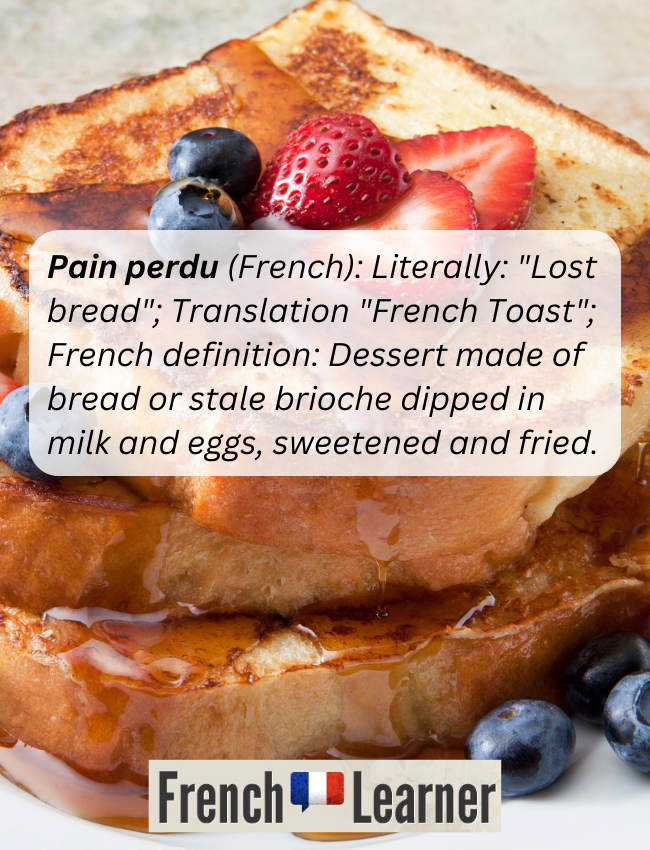And why French toast is called “pain perdu” in French
Do you enjoy freshly-made French toast drizzled in maple syrup? Have you ever wondered why this American breakfast staple is called French toast? Do the French even eat it? If so, why do they call it “pain perdu”? So many questions, with some surprising answers that shine a light on the French language and culture.

Does French toast come from France?
The short answer is no. French toast is not a Gallic invention.
Like many early creations, we can thank ancient Rome for this delicious recipe. An AD 5th-century cookbook Apicius details how to make aliter dulcia (another sweet dish) with fried bread soaked in milk and eggs, then drizzled in honey.
Predictably, the Roman invention was a hit and has appeared in European cuisine ever since.
Sweet and savory variations appeared in medieval cookbooks across Europe, with imaginative names like ‘poor knights’ (Germany, England, and Nordic countries) and bundáskenyér (Hungarian for coated bread.)
In France, the ubiquitous preparation became known as pain perdu. The name means lost bread and was a prized recipe for reviving stale bread.
Origins of the name French toast
It is unclear when the name ‘pain perdu’ was coined.
In the 14th century, the famous royal chef Tallivent mentioned a recipe called tostées dorées. Yet, the name pain perdu first appears in 15th-century English texts, suggesting it was popular outside the king’s kitchen.
Fresh bread in France has changed little since Tallivent’s time. Baguettes are still made with only four ingredients, a requirement protected by the 1993 law, Décret Pain.
A lack of preservatives in bread has ensured pain perdu still has a place in French cuisine, even if eaten infrequently.
This brings us to the origins of the name ‘French toast,’ which is shrouded in myth.
One discredited legend claims it was named after a prolific baker, Joseph French. But the consensus is that French immigrants brought the recipe across the Atlantic, popularizing the dish in French-speaking regions like Louisana.
French toast can be filed alongside English muffins, Belgian waffles, and French fries; European imports absorbed into American cuisine.

Is Pain Perdu popular in France?
Although versions of French toast likely arrived in North America from multiple countries, the name suggests it was especially popular with French immigrants. After all, we don’t call it German toast.
Yet, pain perdu is not widely eaten in France today. Possibly because breakfast is an afterthought in France, where a slice of bread and jam washed down with a stiff coffee is considered a good start to the day.
How is pain perdu eaten in France?
When you encounter pain perdu in France, it is usually served as a dessert. Typical of France, numerous regional variations and names can be found.
Common synonyms include paindorée (golden bread) and dodines. The most perplexing is pain crotte, or bread droppings. Which doesn’t sound too bad until you realize that crotte usually refers to animal droppings.
Despite the limited popularity of pain perdu, there are myriad regional twists.
In Picardy, pain perdu is made with brioche and called gallopin. Gallopin is served in boulangeries and patisseries, often flavored with juniper or flaked almonds.
If you prefer something with a kick, several versions of pain perdu feature a touch of alcohol.
Pain perdu à la Normande is from Normandy and made with a cider-like liqueur called Pommeau de Normandie. Making good use of the region’s renowned orchards, the dish is typically served with apple jam.
In Anjou, pain perdu is sometimes made with orange-flavored triple-sec, like the local Cointreau or Combier. If you’re a fan of French toast, comparing apples and oranges has never been more enjoyable.
One item rarely served with pain perdu is maple syrup. You’ll need to ask for sirop d’érable, which may be available.
However, you won’t have much luck convincing a French kitchen to add sausages and bacon to the plate. Unless you find an American-themed diner, which can be found in unexpected locations across France.
How to pronounce pain perdu
If you find somewhere serving pain perdu, you may want to master the pronunciation.
According to experts, the best phonetic translations are pa~ pehr-dew or pahn pehr–doo.
But to make things even easier here is a short, light-hearted video to help you master the words like a local.
Both pain and perdu are handy French words to know. Especially pain, an emblem of French cuisine.
Hopefully, you’ll find fewer reasons to use the word perdu. Unless you’re hunting for French toast.



